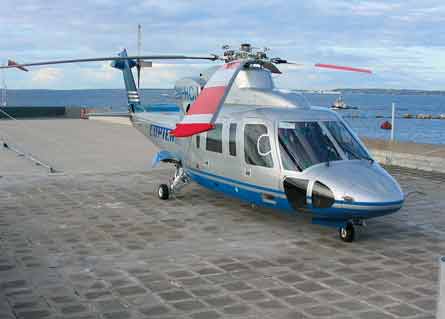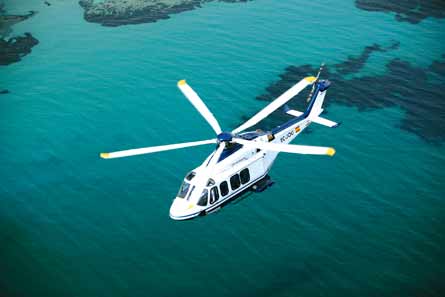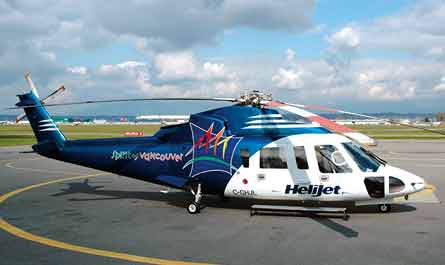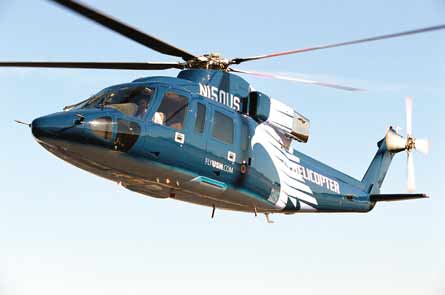The world has few scheduled helicopter services - and their operators are mostly long established. How do they survive and is there room for expansion?
Their wafer-thin profit margins eroded by high fuel costs, the handful of scheduled helicopter airlines around the world continue to operate, but are looking to expand their networks or diversify their services in a bid to thrive, rather than just survive.
With ticket prices remaining obstinately high, and airports studiously ignoring the particular advantages of rotorcraft and treating them just like fixed-wing aircraft, what keeps scheduled helicopter services alive is, in almost every case, a geographical situation that gives point-to-point air travel a distinct advantage over surface transport.
Whether the alternative is a lengthy ferry ride or a drive through congested city streets, the helicopter's freedom from the tyranny of geography has won these scheduled services a loyal customer base, but one that is growing only slowly and is often highly seasonal.
|
|---|
| Copterline has suspended its Sikorsky S-76C+ between the Finnish and Estonian capitals |
Many of the existing scheduled helicopter services are long-established. British International and its forebears, for example, have operated a year-round Sikorsky S-61 service linking the Scilly Isles with Penzance in Cornwall in the south-west UK since 1964. British Columbia, Canada-based Helijet Airways will celebrate the 20th anniversary of its Vancouver-Victoria mainland-to-island commuter service in November, but has achieved profitability in recent months mainly through diversifying into air medical and fishing resort services.
Others are newer. Finland's Copterline started scheduled flights between Helsinki and Tallinn in Estonia in May 2000, but in August last year one of its Sikorsky S-76C+ helicopters crashed into the Baltic Sea soon after take-off, killing all 14 people on board. The service was suspended in June and the remaining S-76C+ sold. Copterline expects to make an announcement on the future of the route in September.
Hong Kong-based HeliExpress, meanwhile, has halted tour and charter operations to focus on its scheduled helicopter services in China's Pearl River delta. HeliExpress operates daily S-76C+ shuttle services from Macau to Hong Kong and Shenzhen and is reportedly in talks to launch services from Hong Kong to Jiangmen via Macau.
In southern Europe, Spanish operator Helisureste (HS) has 10 years of experience in providing flights between the south-eastern city of Malaga and the small territory of Ceuta, one of two Spanish outposts on the north African coast. In April, HS introduced a new AgustaWestland AW139 to its Mediterranean route. The upgrade offers two extra passenger seats and knocks 10min off the 45min flying time of its predecessor, a Bell 412.
Direct connection
The service avoids passengers - mostly business travellers - having to travel 1h by road from Malaga to the Spanish port of Algeciras (near Gibraltar), and then 45min by ferry to Ceuta. Those taking the return service to Malaga can make direct connections with other principal commercial centres of Barcelona, Madrid and Seville. A one-way ticket costs €110 ($140).
Ceuta enjoys a low-tax status similar to that of the UK Channel Islands and Monaco: as a result, every Spanish bank and most large companies have an office there. The HS service was inaugurated in 1996, with a Bell 412 carrying 13 passengers and two pilots. Reduced business traffic during August 2004 led to the service being suspended for a few weeks: the lesson was learned, and now it is cut back during the European holiday season as a matter of routine.
Otherwise the AW139 makes four return trips each weekday. The helicopter operates under instrument flight rules (IFR) and at Malaga the pilots can either descend to a visual reporting point close to the airport or, as a standby, use the instrument landing system. On approach to Ceuta, the machine can descend to 1,000ft (300m) - the lower altitude limit for en route airspace - but if the crew cannot see the landing point it must divert back to Malaga.
Helisureste commercial director Antonio Martinez says: "We chose the 139 for its 20kt [37km/h] speed advantage and a desire, from an image point of view, to introduce a modern type. However, with this helicopter, Ceuta is only 45min from Seville so, since it is also quieter and more comfortable, we are considering connecting those two points." Spain's other North Africa territory of Melilla, further east along the Moroccan coast, is also within range, "but there is an airport there so the demand is not so high", he says.
There is no interline agreement with Spanish flag carrier Iberia, but tickets for the service can be bought at travel agents around the world. "Interlining is an expensive exercise and the airlines already have our passengers for onward travel from Malaga, so there is little advantage," says Martinez.
In contrast to the business-dominated Malaga-Ceuta route, Helisureste's newest service, linking Malta to its outlying island of Gozo, further east in the Mediterranean, is almost entirely tourism-oriented. A local operator used to provide a service with a Mil Mi-8, but when the island joined the European Union in 2004 it could not meet JAR Ops 3 requirements and subsequently HS pitched for the business against (among others) British International. Valetta was careful to stress that the commercial risk rested entirely with the operator and HS's experience to the west was influential.
|
|---|
| Helisureste operates an AgustaWestland AW139 on its routes from southern Spain to north Africa |
A Bell 412EP was introduced, but HS is evaluating a Eurocopter AS365N1 Dauphin, which is cheaper to run over 20 inter-island sectors each day. "Ticket price is an issue because, with the growth of low-cost air travel within Europe, it can be cheaper to fly from London to Malta than it is to fly from Malta to Gozo," says Martinez. "The first year was difficult, but we are now working with several tour operators to run sightseeing tours and other side-trips. It is a 24h operation because we regularly connect with night flights to Luqa [Malta International Airport] from the UK.
"We have also made some test flights to oil rigs off the Libyan coast and, now that the trade embargo has been lifted, we hope to build some new business there. All the majors are looking at prospects in the region, and I'm sure the potential was in everybody's minds when they were pitching for the inter-island contract. We have a head-start, now," he says.
Martinez says HS has also been researching demand within the Balearic islands and between the downtown areas of Las Palmas and Tenerife in the Canary islands. "The Canaries generate a lot of business traffic and the airports are some way from the cities," he says.
Downtown demand
On the other side of the Atlantic, scheduled helicopter service between downtown Manhattan and New York's airports was restarted in late March after a gap of more than 20 years. Start-up operator US Helicopter (USH) is flying three refurbished Sikorsky S-76Bs on hourly services between the Wall Street heliport and New York Kennedy for $159 one-way. The company added two weekday flights between downtown Manhattan and Bridgeport, Connecticut in June, and is due soon to begin an hourly service to Kennedy from the uptown East 34th Street heliport. Services to New York's LaGuardia and Newark airports and from the West 30th Street heliport in west Manhattan should be in place by the end of the year. Starting next year, USH plans to add four new S-76C++ helicopters to its fleet, offering better fuel economy over short legs.
|
|---|
| Canadian operator Helijet Airways will in November celebrate 20 years of scheduled services between Victoria and Vancouver |
Crucial to USH's plans, a Transportation Security Administration checkpoint at the heliport allows passengers of American Airlines (with which USH has a partnership agreement) to pass security, check their bags and get boarding passes through to their final destinations. After an 8min flight and a simultaneous non-conflicting approach, they disembark at American's Terminal 9 (T9) at Kennedy. Passengers with other airlines, however, currently have to go through the security and check-in procedure again at the airport.
Dedicated gate
At Kennedy, American has allocated a widebody stand at T9, which can take three S-76s. USH marketing vice-president Donal McSullivan says the service was launched with American partly because the carrier has a long-term lease on its airport property.
"Their people have been anxious for us to get the operation under way because they recognise the potential for them. There will be a similar arrangement at LaGuardia as well, but the service will not be exclusive to American. Other carriers, including British Airways, are in negotiation with us, but passengers will not be restricted to using partner airlines," McSullivan says.
USH chief executive Jerry Murphy has been involved with helicopters and New York before - he once worked for the Pan American service that used the defunct Westland 31 to fly passengers to its rooftop helipad. US Federal Aviation Administration-approved routes between the three heliports and three airports were successfully demonstrated in mid-February, he says.
"All the flights and approaches are carried out under VFR, avoiding the most built-up areas by flying - as much as possible - over the sea. The flights take between five and eight minutes, compared with up to 2h by road if the conditions are poor," says Murphy.
"Minimum weather limitations are 500ft cloudbase and 1nm [1.8km] visibility into Kennedy and LaGuardia, or 300ft and one mile into Newark. There is no upper height limit, but the sector lengths limit it practically to between 1,500ft and 2,000ft," he adds.
Murphy explains standard procedure: "After contacting Kennedy tower on taking off from the heliport, the next routine call is to American Airlines ground control on approach. Three different approaches have been approved, depending on the airport wind: the crew flies one of them direct to the 'H' on American property, then ground taxis 25ft to the designated gate at T9."
|
|---|
| Under a deal with American Airlines, US Helicopter has a dedicated gate at New York Kennedy airport for its S-76Bs |
Timetable vulnerability
Murphy believes that the two weather risks - fog and icing - will not seriously affect the timetable. "We only get fog once or twice a year and then, of course, the airports will be affected just as much. The maritime environment should prevent icing at our 'en-route' heights, but if the worst happens we will have a limousine service standing by."
The USH model is designed for links between city centre heliports and outlying airports. If the New York service is a success, the company may consider replicating it in Los Angeles, Dallas or Washington DC, rather than setting up city-to-city links.
The company started with used S-76Bs mainly because of their lower cost. "The savings outweighed its performance disadvantage over such short legs," says Murphy. Start-up costs for the new service have been "less than $2 million", says McSullivan. USH is hoping to carry 150,000 passengers in its first year. If this target is met, says Murphy, "we might be interested in the [Sikorsky] S-92 with its increased capacity". ■
Source: Flight International



























